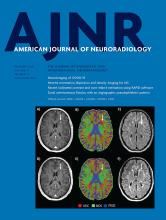Index by author
Keith, J.
- EDITOR'S CHOICENeurointerventionYou have accessEndovascular Cerebral Venous Sinus Imaging with Optical Coherence TomographyC.R. Pasarikovski, J.C. Ku, J. Keith, J. Ramjist, Y. Dobashi, S.M. Priola, L. da Costa and V.X.D. YangAmerican Journal of Neuroradiology December 2020, 41 (12) 2292-2297; DOI: https://doi.org/10.3174/ajnr.A6909
Endovascular optical coherence tomography imaging was feasible in this preclinical animal study. Adoption of this imaging technique in the human cerebral venous sinus could aid in the diagnosis, treatment, and understanding of the pathophysiology of various diseases of the sinus.
Kesav, P.
- FELLOWS' JOURNAL CLUBNeurointerventionOpen AccessCharacteristics of Large-Vessel Occlusion Associated with COVID-19 and Ischemic StrokeS. John, P. Kesav, V.A. Mifsud, B. Piechowski-Jozwiak, J. Dibu, A. Bayrlee, H. Elkambergy, F. Roser, M.S. Elhammady, K. Zahra and S.I. HussainAmerican Journal of Neuroradiology December 2020, 41 (12) 2263-2268; DOI: https://doi.org/10.3174/ajnr.A6799
Consecutive ischemic stroke and TIA admissions (COVID and non-COVID) to the authors' hospital during a 10-week period from March 1 to May 10, 2020 were collected and compared with data from the same time period in 2019. Among 20 patients with COVID-19 and acute ischemic stroke, 15 (75%) had large-vessel occlusion. These patients were young (mean age, 46.5 years), male (93%), without major burden of traditional cardiovascular risk factors, and had a severe stroke presentation. Large vessel occlusions were observed in multiple vessels (40%), uncommonly affected vessels, and atypical locations with a large thrombus burden.
Khangura, R.S.
- EDITOR'S CHOICEAdult BrainOpen AccessRecent Administration of Iodinated Contrast Renders Core Infarct Estimation Inaccurate Using RAPID SoftwareA.Z. Copelan, E.R. Smith, G.T. Drocton, K.H. Narsinh, D. Murph, R.S. Khangura, Z.J. Hartley, A.A. Abla, W.P. Dillon, C.F. Dowd, R.T. Higashida, V.V. Halbach, S.W. Hetts, D.L. Cooke, K. Keenan, J. Nelson, D. Mccoy, M. Ciano and M.R. AmansAmerican Journal of Neuroradiology December 2020, 41 (12) 2235-2242; DOI: https://doi.org/10.3174/ajnr.A6908
Patients who received IV iodinated contrast in proximity (<8 hours) to CTA/CTP as part of a separate imaging study had a much higher likelihood of core infarct underestimation with RAPID software compared with contrast-naive patients. Over-reliance on RAPID postprocessing for treatment disposition of patients with extended window emergent large-vessel occlusion should be avoided, particularly in cases with recent IV contrast administration.
Kidokoro, H.
- Adult BrainYou have accessAcute Necrotizing Encephalopathy: A Disease Meriting Greater RecognitionH. KidokoroAmerican Journal of Neuroradiology December 2020, 41 (12) 2255-2256; DOI: https://doi.org/10.3174/ajnr.A6821
Kikuchi, T.
- Adult BrainOpen AccessCortical Distribution of Fragile Periventricular Anastomotic Collateral Vessels in Moyamoya Disease: An Exploratory Cross-Sectional Study of Japanese Patients with Moyamoya DiseaseA. Miyakoshi, T. Funaki, Y. Fushimi, T. Nakae, M. Okawa, T. Kikuchi, H. Kataoka, K. Yoshida, Y. Mineharu, M. Matsuhashi, E. Nakatani and S. MiyamotoAmerican Journal of Neuroradiology December 2020, 41 (12) 2243-2249; DOI: https://doi.org/10.3174/ajnr.A6861
Killer-oberpfalzer, M.
- FELLOWS' JOURNAL CLUBNeurointerventionYou have accessTreatment of Ruptured Blister-Like Aneurysms with the FRED Flow Diverter: A Multicenter ExperienceM.A. Möhlenbruch, F. Seker, E. Özlük, O. Kizilkilic, E. Broussalis, M. Killer-Oberpfalzer, C.J. Griessenauer, M. Bendszus and N. KocerAmerican Journal of Neuroradiology December 2020, 41 (12) 2280-2284; DOI: https://doi.org/10.3174/ajnr.A6849
In a retrospective multicenter study, all patients treated with the FRED for a ruptured intracranial blister-like aneurysm between January 2013 and May 2019 were analyzed. In total, 30 patients with 30 ruptured blister-like aneurysms were treated. Immediate complete aneurysm obliteration with the FRED was achieved in 10 patients (33%). Of the 26 patients with follow-up, complete obliteration was achieved in 21 patients (80%) after 6 months and in 24 patients (92%) in the final follow-up (median, 22 months). The authors conclude that treatment of ruptured blister-like aneurysms with the FRED is safe and effective.
Kim, H.
- Head and Neck ImagingOpen AccessMRI-Based Assessment of the Pharyngeal Constrictor Muscle as a Predictor of Surgical Margin after Transoral Robotic Surgery in HPV-Positive Tonsillar CancerY.J. Kim, W.-J. Jeong, Y.J. Bae, H. Kim, B.S. Choi, Y.H. Jung, S.H. Baik, L. Sunwoo and J.H. KimAmerican Journal of Neuroradiology December 2020, 41 (12) 2320-2326; DOI: https://doi.org/10.3174/ajnr.A6806
- NeurointerventionOpen AccessInterrater Reliability in the Measurement of Flow Characteristics on Color-Coded Quantitative DSA of Brain AVMsK.H Narsinh, K. Mueller, J. Nelson, J. Massachi, D.C. Murph, A.Z. Copelan, S.W. Hetts, V.V. Halbach, R.T. Higashida, A.A. Abla, M.R. Amans, C.F. Dowd, H. Kim and D.L. CookeAmerican Journal of Neuroradiology December 2020, 41 (12) 2303-2310; DOI: https://doi.org/10.3174/ajnr.A6846
Kim, J.H.
- Head and Neck ImagingOpen AccessMRI-Based Assessment of the Pharyngeal Constrictor Muscle as a Predictor of Surgical Margin after Transoral Robotic Surgery in HPV-Positive Tonsillar CancerY.J. Kim, W.-J. Jeong, Y.J. Bae, H. Kim, B.S. Choi, Y.H. Jung, S.H. Baik, L. Sunwoo and J.H. KimAmerican Journal of Neuroradiology December 2020, 41 (12) 2320-2326; DOI: https://doi.org/10.3174/ajnr.A6806
Kim, M.-J.
- Adult BrainOpen AccessDevelopment and Validation of a Deep Learning–Based Automatic Brain Segmentation and Classification Algorithm for Alzheimer Disease Using 3D T1-Weighted Volumetric ImagesC.H. Suh, W.H. Shim, S.J. Kim, J.H. Roh, J.-H. Lee, M.-J. Kim, S. Park, W. Jung, J. Sung, G.-H. Jahng, and for the Alzheimer’s Disease Neuroimaging InitiativeAmerican Journal of Neuroradiology December 2020, 41 (12) 2227-2234; DOI: https://doi.org/10.3174/ajnr.A6848
Kim, S.J.
- Adult BrainOpen AccessDevelopment and Validation of a Deep Learning–Based Automatic Brain Segmentation and Classification Algorithm for Alzheimer Disease Using 3D T1-Weighted Volumetric ImagesC.H. Suh, W.H. Shim, S.J. Kim, J.H. Roh, J.-H. Lee, M.-J. Kim, S. Park, W. Jung, J. Sung, G.-H. Jahng, and for the Alzheimer’s Disease Neuroimaging InitiativeAmerican Journal of Neuroradiology December 2020, 41 (12) 2227-2234; DOI: https://doi.org/10.3174/ajnr.A6848








